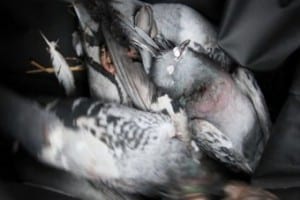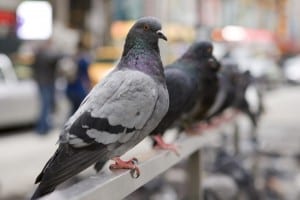
by johnnymarin | Jan 16, 2019 | Pigeons in the News
 Police are investigating the discovery of several dead birds in a park in Tokyo’s Kita Ward. At around noon on Jan 13, four pigeons and five sparrows were found dead in Kamiya Park, Fuji TV reported.
Police are investigating the discovery of several dead birds in a park in Tokyo’s Kita Ward. At around noon on Jan 13, four pigeons and five sparrows were found dead in Kamiya Park, Fuji TV reported.
The birds had no external injuries and there were remnants of rice grain scattered nearby, leading police to suspect that the birds may have been poisoned.
In October last year, 18 pigeons that had eaten corn dipped in agricultural chemicals were found dead in Akabane Park. Similar incidents of other birds and feral cats being poisoned have also been reported in the area.
Police said whoever is responsible faces charges for violation of the Wildlife Protection Law.
About Pigeon Patrol:
Pigeon Patrol Products & Services is the leading manufacturer and distributor of bird deterrent (control) products in Canada. Pigeon Patrol products have solved pest bird problems in industrial, commercial, and residential settings since 2000, by using safe and humane bird deterrents with only bird and animal friendly solutions. At Pigeon Patrol, we manufacture and offer a variety of bird deterrents, ranging from Ultra-flex Bird Spikes with UV protection, Bird Netting, 4-S Gel and the best Ultrasonic and audible sound devices on the market today.
Voted Best Canadian wholesaler for Bird Deterrent products four years in a row.
Contact Info: 1- 877– 4– NO-BIRD (www.pigeonpatrol.ca)

by johnnymarin | Jan 15, 2019 | Pigeons in the News
 Gyanoday Primary School had shut in 2012 and is now home to two buffaloes.
Gyanoday Primary School had shut in 2012 and is now home to two buffaloes.
One can also find pigeons fluttering to a pigeonhole but not students, teachers, desk and blackboards.
Who let the buffaloes in?
The answer is clear in Gopaldhara-Rangbhang valley: successive politicians who ruled the hills but dragged their feet to put in place a proper education system.
The school, 7km from here, was established in 1995 by the Subash Ghisingh-headed Darjeeling Gorkha Hill Council (DGHC).
The school started with no permanent teachers. Four volunteers used to teach the 45-odd students.
“I have a family to support. How long can one carry without salaries?” asked Aswain Thami, a former volunteer teacher.
One of his colleagues joined Gopaldhura tea garden office, while two lady volunteers preferred to be permanent homemakers.
Thami landed a civic police job in 2014.
Local people made submissions to not only Ghisingh but also Bimal Gurung when he was heading the Gorkhaland Territorial Administration.
They have recently taken up the matter with local Gorkha Janmukti Morcha leaders who are now with Binay Tamang, the GTA head. “We have been told that our grievances will be redressed soon,” said Suman Yolmo, a managing committee member.
“If at least one permanent teacher is appointed, the school would still be functional,” rued Thami.
Primary school teacher’s examination was last held in 2001 and the appointment letters were released the following year.
Amar Singh Rai, GTA (education in-charge), admitted that primary and secondary education system was in “a mess” in the hills. “There has to be a proper recruitment system,” said Rai.
The School Service Commission has been defunct in the hills since 2003. Ghisingh opposed the commission demanding that its power be transferred to the DGHC.
“There are vacancies of 652 primary teachers now. For some reason, the earlier GTA did not pursue this issue but the state government has asked us to submit rules for appointing the teachers,” said Rai.
“The rules have been submitted. Once the matter related to the 652 teachers is taken care of, we will have to put in place a proper system,” said Rai.
“The school building has developed cracks and needs repaired,” said Yolmo.
Less than 50ft away stands a glittering three-storied “guest house” that was patronised both by Ghisingh and Gurung. The buzz is that Rs 74 lakh was spent on the “guest house”.
Till date, no guests have arrived.
It’s a solace for the school which has no students.
About Pigeon Patrol:
Pigeon Patrol Products & Services is the leading manufacturer and distributor of bird deterrent (control) products in Canada. Pigeon Patrol products have solved pest bird problems in industrial, commercial, and residential settings since 2000, by using safe and humane bird deterrents with only bird and animal friendly solutions. At Pigeon Patrol, we manufacture and offer a variety of bird deterrents, ranging from Ultra-flex Bird Spikes with UV protection, Bird Netting, 4-S Gel and the best Ultrasonic and audible sound devices on the market today.
Voted Best Canadian wholesaler for Bird Deterrent products four years in a row.
Contact Info: 1- 877– 4– NO-BIRD (www.pigeonpatrol.ca)

by johnnymarin | Jan 14, 2019 | Bird Deterrent Products
 This is the bizarre moment a man feeds his two pet pigeons with seed held in his mouth.
This is the bizarre moment a man feeds his two pet pigeons with seed held in his mouth.
In the video, the man is seen sitting on a stone with a pigeon on each shoulder.
The man then opens his mouth which is full of grain and lets the birds feed on it together.
The birds continue to feed on the grain until their hunger is satisfied.
The pet owner said: ”I am quite attached to my birds and I like to feed them from my mouth.
”If I put the grains on the ground they won’t eat, they will eat only from my mouth. After they are done eating, they fly away.”
About Pigeon Patrol:
Pigeon Patrol Products & Services is the leading manufacturer and distributor of bird deterrent (control) products in Canada. Pigeon Patrol products have solved pest bird problems in industrial, commercial, and residential settings since 2000, by using safe and humane bird deterrents with only bird and animal friendly solutions. At Pigeon Patrol, we manufacture and offer a variety of bird deterrents, ranging from Ultra-flex Bird Spikes with UV protection, Bird Netting, 4-S Gel and the best Ultrasonic and audible sound devices on the market today.
Voted Best Canadian wholesaler for Bird Deterrent products four years in a row.
Contact Info: 1- 877– 4– NO-BIRD (www.pigeonpatrol.ca)

by johnnymarin | Jan 13, 2019 | Pigeons in the News
 Around 25,000 pigeon fanciers will be flocking to the Winter Gardens this weekend when the annual British Homing World Show returns to the town. The event, now in its 47th year, has been coming to the resort for 41 years and is worth an estimated £2.5 million to the Blackpool economy. Over the two-day event, there will be over 100 trade stands, charity pigeon auctions, raffles for new lofts and the showing and judging of over 2,000 of the top homing pigeons in the country. It all takes place on Saturday and Sunday. Ian Evans, CEO of organisers the Royal Pigeon Racing Association (RPRA), said: “Pigeon racing is not simply just a hobby for the fancying community. “For many, the past time helps people to stay active and social. “The population of pigeon fanciers is made up of those from all different backgrounds and the event is a great chance for our members to catch up.” READ MORE: Pigeon fanatics migrated to Blackpool’s Empress Ballroom for The British Homing World Show of the Year He said the event in Blackpool was also an opportunity for the RPRA to launch its junior membership scheme to encourage the younger generation to keep our pastime thriving. The BBC’s national security correspondent Gordon Corera will also be signing his book, ‘The Secret Pigeon Service’ at the event. The book is based on a story about the 16,000 homing pigeons which were dropped in an arc from Bordeaux to Copenhagen as part of ‘Columba’ – a secret British operation to bring back intelligence from those living under Nazi occupation. The event’s £2.5m injection into the Blackpool economy is based on the trade it brings in for hotels, restaurants, taxis and other businesses at a time of year when the town would otherwise be quiet.
Around 25,000 pigeon fanciers will be flocking to the Winter Gardens this weekend when the annual British Homing World Show returns to the town. The event, now in its 47th year, has been coming to the resort for 41 years and is worth an estimated £2.5 million to the Blackpool economy. Over the two-day event, there will be over 100 trade stands, charity pigeon auctions, raffles for new lofts and the showing and judging of over 2,000 of the top homing pigeons in the country. It all takes place on Saturday and Sunday. Ian Evans, CEO of organisers the Royal Pigeon Racing Association (RPRA), said: “Pigeon racing is not simply just a hobby for the fancying community. “For many, the past time helps people to stay active and social. “The population of pigeon fanciers is made up of those from all different backgrounds and the event is a great chance for our members to catch up.” READ MORE: Pigeon fanatics migrated to Blackpool’s Empress Ballroom for The British Homing World Show of the Year He said the event in Blackpool was also an opportunity for the RPRA to launch its junior membership scheme to encourage the younger generation to keep our pastime thriving. The BBC’s national security correspondent Gordon Corera will also be signing his book, ‘The Secret Pigeon Service’ at the event. The book is based on a story about the 16,000 homing pigeons which were dropped in an arc from Bordeaux to Copenhagen as part of ‘Columba’ – a secret British operation to bring back intelligence from those living under Nazi occupation. The event’s £2.5m injection into the Blackpool economy is based on the trade it brings in for hotels, restaurants, taxis and other businesses at a time of year when the town would otherwise be quiet.
About Pigeon Patrol:
Pigeon Patrol Products & Services is the leading manufacturer and distributor of bird deterrent (control) products in Canada. Pigeon Patrol products have solved pest bird problems in industrial, commercial, and residential settings since 2000, by using safe and humane bird deterrents with only bird and animal friendly solutions. At Pigeon Patrol, we manufacture and offer a variety of bird deterrents, ranging from Ultra-flex Bird Spikes with UV protection, Bird Netting, 4-S Gel and the best Ultrasonic and audible sound devices on the market today.
Voted Best Canadian wholesaler for Bird Deterrent products four years in a row.
Contact Info: 1- 877– 4– NO-BIRD (www.pigeonpatrol.ca)

by johnnymarin | Jan 12, 2019 | Pigeons in the News
 On April 16, 1919, the troop transport Ohioan docked at Hoboken, New Jersey. Among the various disembarking members of the American Expeditionary Forces was a small detachment of 21 men of the U.S. Army Signal Corp’s Pigeon Service Company No. 1. Pier-side newspaper reporters flocked around the officer in charge, Capt. John L. Carney, to ask about the exploits of the distinguished hero pigeons the Army chose to bring home. Foremost among the latter was an English-bred black check hen named Cher Ami. As Carney told the story, it was Cher Ami who on October 4, 1918 braved shot and shell to deliver a message from the besieged men of a composite force surrounded in the Charlevaux Ravine of the Argonne Forest, forever known as “The Lost Battalion.” Cher Ami arrived at her loft with the intact message from the force’s commander, Maj. Charles W. Whittlesey, albeit minus a right leg and with a wound clear across the chest cutting through the breast bone. Cher Ami survived her injuries and Whittlesey’s message provided the exact position of his force back to the regimental and divisional headquarters, information which contributed to the eventual relief of the men.
On April 16, 1919, the troop transport Ohioan docked at Hoboken, New Jersey. Among the various disembarking members of the American Expeditionary Forces was a small detachment of 21 men of the U.S. Army Signal Corp’s Pigeon Service Company No. 1. Pier-side newspaper reporters flocked around the officer in charge, Capt. John L. Carney, to ask about the exploits of the distinguished hero pigeons the Army chose to bring home. Foremost among the latter was an English-bred black check hen named Cher Ami. As Carney told the story, it was Cher Ami who on October 4, 1918 braved shot and shell to deliver a message from the besieged men of a composite force surrounded in the Charlevaux Ravine of the Argonne Forest, forever known as “The Lost Battalion.” Cher Ami arrived at her loft with the intact message from the force’s commander, Maj. Charles W. Whittlesey, albeit minus a right leg and with a wound clear across the chest cutting through the breast bone. Cher Ami survived her injuries and Whittlesey’s message provided the exact position of his force back to the regimental and divisional headquarters, information which contributed to the eventual relief of the men.
Cher Ami’s story remains legendary to this day, a testament to the bravery of animals in war. The story, although the records are uncertain if Cher Ami or another pigeon delivered Whittlesey’s message, often obscures the purposes underlying the use of homing pigeons by the U.S. Army. From 1917 to 1957, the Signal Corps maintained pigeon breeding and training facilities, and birds saw service in World War II and Korea. When the pigeon service disbanded in 1957, the Army contended that advances in electronic communications rendered the peacetime maintenance of pigeon breeding and training facilities unnecessary. The remaining pigeons were sold at auction, with a select few being donated to zoos around the nation. Today the use of homing pigeons is viewed as novelty, a quirky vignette of the early 20th century battlefield.
Over 60 years later, the military homing pigeon warrants reexamination. The electromagnetic spectrum’s influence extends throughout the systems and operations of the battlespace into the fabric of civil society. Offensive and defensive operations in the cyber space realm, combined with kinetic strikes on air, land, sea, or space-based infrastructure, could potentially disable or severely damage entire communication or power grids. Adversaries with electronic warfare dominance would then be positioned to control the battlespace and restrict the options presented to American or allied commanders. Reflecting on electronic warfare’s potential, some communications between the front lines of the battlefield and rear echelon command and control elements may need to rest on the legs or back of a feathered messenger when a human runner or more visible vehicle or aircraft may prove too vulnerable to interception or destruction.
In an era where military innovation may conjure up thoughts about futuristic weapons and high-dollar research, development, and acquisition, perhaps consider an innovation redux: the homing pigeon. A brief examination of the American military experience with homing pigeons offers insights into both the utility of the birds and their advantages in the modern electronic warfare battlespace.
Pigeon Primer
Homing pigeons are relatives of the rock dove, Columba livia, which frequently conduct seize and hold or tactical air strikes on urban residents and residences worldwide. Homing pigeons, however, are more akin to race horses, carefully bred and nursed to maximize speed, endurance, and navigational prowess. As with race horses, loft owners do not shy from spending $1,000s to 100s of $1,000s for champion pigeons in hopes of breeding future generations of race success. The exact science is unclear, but theories postulate as to how the pigeons navigate, returning to their home lofts either through visual, magnetorepton, or olfactory means. The distances flown by homing pigeons can vary from 10s to over a 1,000 miles over unfamiliar terrain or open water, at speeds from 60 to over 90 miles per hour. A pigeon can sustain grievous injury in flight and continue on its journey home, as was the case with Cher Ami and other military pigeons in both world wars.
The use of pigeons for military purposes extends back centuries, but World War I introduced widespread battlefield use of the birds by both the Central and Entente powers Previously, pigeons saw use in the 1800s primarily in journalism, with military use only rekindled in the Franco-Prussian War during the Siege of Paris. Following American entry into World War I, French and British officials championed the value of homing pigeons after the experiences at Verdun and the Somme. In trench warfare, where artillery bombardments turned carefully laid telephone lines into confetti, pigeons proved the only reliable means of communication between the front trenches and the artillery and command elements in the rear. Neither bombardment, dust, smoke, poison gas, or fog grounded the feathered messengers. For the British at the Somme, pigeon liaison was “always . . . able to operate regularly. In many cases it was the only one which was able to resist the weather and the means of destruction of the enemy.” Thereafter, the Army Signal Corps wasted little time in establishing a pigeon service in July 1917, utilizing Allied experience with a proven technology to address communication issues. Work continued to refine and improve wired and wireless communication systems for the battlefield, but off-the-shelf pigeon technology ensured the men of the American Expeditionary Forces would not be caught ill-prepared in a communication blackout when electronic means or runners fell to enemy fire.
Pigeons demonstrated reliability as messengers and the ability for usage with a variety of forces. In World War I, the Signal Corps reported an overall message delivery rate of 95 percent. In 1944, the Army reported pigeon-delivered tactical message rates at 99 percent. After success with combat operations in Europe in World War I, the U.S. military employed pigeons in the Pacific, Europe, and North Africa in the second war. Messages evolved from small pieces of rice paper to sections of map grids to eventual exposed photographic film. In World War I, pigeons served in the Tank Corps, Air Service, and with naval aviation. In World War II, pigeons served everywhere with everyone. They took part in Operation Overlord with paratroopers in the 101st and 82nd Airborne Divisions, and were carried up the cliffs at Pointe du Hoc with the Rangers in special containers. Other birds parachuted into Burma with members of the Office of Strategic Services, carrying messages behind enemy lines, while others found a home inside the confines of Sherman tanks. Thousands of birds found work aboard the heavy bombers of the Army Air Forces in raids over Europe. In the Italian campaign, pigeons proved invaluable in transmitting messages over rugged terrain to coordinate fire missions for aircraft or artillery. Much as pigeons can adapt and thrive in practically every environ on the planet, the same held true for military employment of the birds.
Beginning in 1917 and continuing with World War II, the Army’s pigeon force drew from the civilian racing pigeon community. In 1917, the American Expeditionary Forces’ Pigeon Service tapped two founding members of the American Racing Pigeon Union — John L. Carney and David C. Buscall — to receive direct commissions as first lieutenants to build up the pigeon force from scratch. Both men, coincidentally current or former non-commissioned officers in the Army and Marine Corps, respectively, brought with them the highly specialized knowledge and background required to acquire, train, breed, and distribute pigeons to forces in the field. Through their civilian contacts, the men acquired via purchase or donation large numbers of quality racing pigeons and helped recruit the non-commissioned officers necessary to staff and train pigeon handlers in Northern France. The necessity to build and field pigeons for the American Expeditionary Forces further demonstrated how the specialized nature of pigeon work put a premium on civilian pigeon knowledge within the ranks.
Postwar, the Army continued the pattern of working closely with civilian organizations, such as the American Racing Pigeon Union, in recruiting men from the pigeon racing community. When the Army needed to rapidly expand the pigeon force in World War II, the civilian community responded with donations of tens of thousands of birds and even World War I “retread” volunteers for the officer and enlisted ranks to tend and train the pigeons. Never a large or overly expensive force, Army “pigeoneers” ensured communication continuity for the fighting men at the front, albeit always as a secondary or emergency method of transmission. Regardless of its size or lack of panache, the men of the Pigeon Service represent a solid example of a civil-military partnership able to respond to a wartime necessity in an orderly, efficient fashion.
Pigeons Presently?
For the contemporary challenges of cyberwarfare and electronic warfare, Army Futures Command should examine the record of the Army’s disbanded Pigeon Service. From the experience of the two world wars, the pigeon effort took off through partnership with civilian organizations. Akin to the Cyber Direct Commissioning Program, by recruiting and providing advanced grade to pigeon specialists for their civilian training, the Army staffed the officer and non-commissioned ranks with knowledge and skills essential for rapid expansion at minimum cost in training and the associated infrastructure therein. Furthermore, the connections of these citizen-soldiers further provided entre into acquiring quality homing pigeon stock from the civilian community for the Army with minimal delay. The ability to then “surge” a pigeon force became possible, in part to the small peacetime Pigeon Service then in existence.
In the arena of technology, pigeons are decidedly mundane messengers yet proven and reliable. The use of off-the-shelf technology at a time of need in 1917 served the Army faithfully for half a century. A similar acquisition success is found in the Army’s “Big Five” acquisition. Col. David C. Trybula concludes that by incorporating mature or maturing technologies into the systems, the results proved “extraordinary and perhaps revolutionary” when compared to the systems being replaced. While not arguing that homing pigeon technology can replace the advanced communications technologies of today, there are advantages to contemplate in the electronic warfare environment.
As the fighting in the Donbass region of Ukraine and in Syria have demonstrated, electromagnetic security can be a matter of life and death, of light and darkness. Through electronic warfare methods, Russian-backed separatist forces have caused an array of difficulties for Ukrainian forces. In the current fighting in Syria, American forces have likewise come face to face with Russian electronic warfare technologies and tactics, an electronic warfare battlefield-turned-proving ground for future conflicts. Monitoring, jamming, or infiltrating electronic-based systems to enable or deny kinetic effects places a premium on protecting signal communication.
Pigeons are certainly no substitute for drones, but they provide a low-visibility option to relay information. Considering the storage capacity of microSD memory cards, a pigeon’s organic characteristics provide front line forces a relatively clandestine mean to transport gigabytes of video, voice, or still imagery and documentation over considerable distance with zero electromagnetic emissions or obvious detectability to radar. These decidedly low-technology options prove difficult to detect and track. Pigeons cannot talk under interrogation, although they are not entirely immune to being held under suspicion of espionage. Within an urban environment, a pigeon has even greater potential to blend into the local avian population, further compounding detection. The latter presumably factored into the use of pigeons to clandestinely smuggle drugs, defeating even the most sophisticated of walls.
Furthermore, pigeons provide an asymmetric tool available for hybrid warfare purposes. The low-cost, low-technology use of pigeons to transport information or potentially small amounts of chemical agents — or even coded cyber weapons — makes them a quick and easy asset to distribute among a civilian population for wider military purposes. During World War II, the British Confidential Pigeon Service of MI14(d) dropped baskets of homing pigeons behind enemy lines for espionage purposes, gathering invaluable military intelligence in the process from a wide array of French, Dutch, and Belgian civilians. Even as a one-way means of communication, the pigeon proved an invaluable military asset.
The ideas herein are not claimed to be unique or refined. Military pigeon forces are all but extinct, but yet the Chinese People’s Liberation Army and French Ground Army maintain small pigeon forces in the event that electronic warfare should disrupt or disable military communications. As for the American military, the only traces of its pigeon force can be found in artifacts or photographs in museums around the country. The use of military homing pigeons in the 21st century in similar or more creative ways is limited only by initiative and imagination — a statement true for most any battlefield innovation and the disrupting potential of electronic warfare.
About Pigeon Patrol:
Pigeon Patrol Products & Services is the leading manufacturer and distributor of bird deterrent (control) products in Canada. Pigeon Patrol products have solved pest bird problems in industrial, commercial, and residential settings since 2000, by using safe and humane bird deterrents with only bird and animal friendly solutions. At Pigeon Patrol, we manufacture and offer a variety of bird deterrents, ranging from Ultra-flex Bird Spikes with UV protection, Bird Netting, 4-S Gel and the best Ultrasonic and audible sound devices on the market today.
Voted Best Canadian wholesaler for Bird Deterrent products four years in a row.
Contact Info: 1- 877– 4– NO-BIRD (www.pigeonpatrol.ca)

 Police are investigating the discovery of several dead birds in a park in Tokyo’s Kita Ward. At around noon on Jan 13, four pigeons and five sparrows were found dead in Kamiya Park, Fuji TV reported.
Police are investigating the discovery of several dead birds in a park in Tokyo’s Kita Ward. At around noon on Jan 13, four pigeons and five sparrows were found dead in Kamiya Park, Fuji TV reported.



